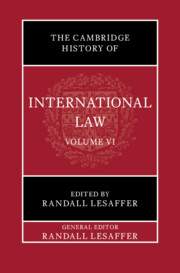Book contents
- The Cambridge History of International Law
- The Cambridge History of International Law
- Frontispiece
- The Cambridge History of International Law
- Copyright page
- Contents
- Plates
- Contributors
- Preface
- Abbreviations
- Part I International Law in Renaissance Europe (1492–1660)
- 1 The Law of Nations in Renaissance Europe
- 2 Territory and Jurisdiction in Renaissance Europe
- 3 Beyond the Free Sea
- 4 War and the Use of Force in Renaissance Europe
- 5 Warfare on Land in Renaissance Europe
- 6 The Law of Maritime Warfare during the Transition between Medieval and Early Modern Europe
- 7 Peacemaking in Renaissance Europe
- 8 Trade and Navigation in Renaissance Europe
- 9 Diplomacy in Renaissance Europe
- 10 Dispute Settlement in Renaissance Europe
- 11 The Ottoman Encounter and the Law of Nations in the Renaissance
- Part II International Law in Old Regime Europe (1660–1775)
- Index
- Plate Section (PDF Only)
- References
4 - War and the Use of Force in Renaissance Europe
from Part I - International Law in Renaissance Europe (1492–1660)
Published online by Cambridge University Press: 22 April 2025
- The Cambridge History of International Law
- The Cambridge History of International Law
- Frontispiece
- The Cambridge History of International Law
- Copyright page
- Contents
- Plates
- Contributors
- Preface
- Abbreviations
- Part I International Law in Renaissance Europe (1492–1660)
- 1 The Law of Nations in Renaissance Europe
- 2 Territory and Jurisdiction in Renaissance Europe
- 3 Beyond the Free Sea
- 4 War and the Use of Force in Renaissance Europe
- 5 Warfare on Land in Renaissance Europe
- 6 The Law of Maritime Warfare during the Transition between Medieval and Early Modern Europe
- 7 Peacemaking in Renaissance Europe
- 8 Trade and Navigation in Renaissance Europe
- 9 Diplomacy in Renaissance Europe
- 10 Dispute Settlement in Renaissance Europe
- 11 The Ottoman Encounter and the Law of Nations in the Renaissance
- Part II International Law in Old Regime Europe (1660–1775)
- Index
- Plate Section (PDF Only)
- References
Summary
In Renaissance Europe, war and the use of force were regular phenomena and likewise subject of common rules. The theory of ‘just war’, dating back to ancient times, was further developed by legal scholars, and all belligerents claimed to have a just cause, often explained in printed pamphlets. International law consisted of theory and practice, and thus, they should be considered in a mutual context. The focus was still on the question of who had a right to wage war, i.e. on the jus ad bellum, and barely on regulations of warfare or on a containment of war. International law in Renaissance Europe rooted in its very society, in its rules and values. Legal debates and war justifications consolidated the Christian European community, which even in war times did not break apart, even if it was contradictory to the principle of sovereignty and the idea that a sovereign owes no justification to anyone. Moreover, scholars and belligerents argued with natural law and insisted in the universality of international law, although it was in fact basically European. Thus, in Renaissance Europe well-established traditions existed for how to handle war, but they were more and more challenged by the idea of sovereignty, as well as by the European expansion and by global interaction.
- Type
- Chapter
- Information
- The Cambridge History of International Law , pp. 135 - 170Publisher: Cambridge University PressPrint publication year: 2025

